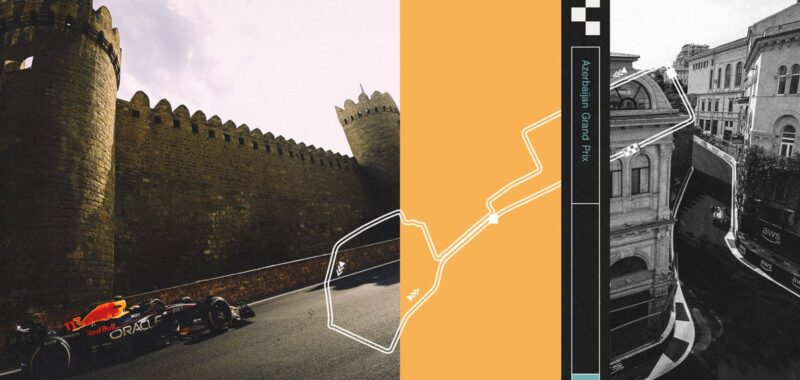Stay informed on all the biggest stories in Formula 1. Sign up here to receive the Prime Tire newsletter in your inbox every Monday and Friday.
The traditional European leg of Formula One’s world tour is complete as the sport heads to Azerbaijan.
Located in eastern Transcaucasia, Azerbaijan lies between the Caspian Sea and the Caucasus Mountains. At 900 miles from the nearest F1 event location in Bahrain, only the Australian GP and São Paulo GP are more isolated. The country is known for the medieval Inner City, which is situated within the capital and site of the race, Baku.
The nation was part of the Soviet Union before becoming independent in October 1991. It wasn’t for another two decades until Baku’s racing association began GT racing in the city, and F1 didn’t take the streets until 2016 in the form of the European Grand Prix.
The Baku City Circuit, home to one of F1’s longest straights, presents a unique mix of challenges. The layout is a blend of open space, like at Turn 1, and narrow passages between walls. The track’s margins are razor-thin in some areas, and even minor errors can lead to significant punishments, similar to Monaco.
“The trickiest thing in Baku is braking,” Daniel Ricciardo said in 2018. “There’s so many braking points where you have to commit and you have to brake as late as you can. But there’s no room for error. Once you’ve committed to that braking point, if you’ve locked a wheel, you’re in the wall.
This track has seen last-lap drama, clashing champions and plenty of overtakes, even going three-wide. Before the drivers and teams hit the track, here’s what you need to know about a street circuit that mixes old with new.
“The hardest part about Baku is finding the limit with braking, and just having that confidence.”

A history-filled circuit
Hermann Tilke designed the Baku City Circuit, and according to racingcircuits.info, the goal was to include multiple historic landmarks. The final product, a six-kilometer-long track, passes the UNESCO-protected 15th-century Maiden Tower and the Palace of the Shirvanshahs.
Teams must opt for a more compromised car set-up at this track because of the varying demands. RB technical director Jody Eggington said in the team’s preview that Baku City Circuit “provides a good mix of challenges for the engineers and drivers with a long straight requiring good aerodynamic efficiency, as cars can exceed 345 km/h, while the 20 corners, which are predominantly slower speed, make strong demands on braking and traction performance.”
Teams likely will trim out the downforce and opt for skinnier wings to help increase top speed. As the cars navigate the first sector, the drivers zip through the government quarter. Those early 90-degree turns (and heavy braking zones) take the drivers past some modern architecture, starkly contrasting the tight, walled streets in the Old City portion of Sector 2. Baku is the home of the narrowest corner of the calendar, Turn 8, which is 7.6 meters (24.934 feet) wide at the narrowest part. But out of Turn 12, the drivers can go on a full-throttle run through Turn 15, home of a tricky downhill braking point.

Daniel Ricciardo driving for Red Bull during qualifying for the Azerbaijan Grand Prix in 2018. (Dan Istitene/Getty Images)
Turn 16 is the first corner in Sector 3, which includes the wide boulevard of Neftchilar Avenue. Drivers can go full throttle to the end, and the lap starts again with the favored overtaking spot of Turn 1, where they can go three-wide. Remember Ricciardo’s move in 2017?
“The Baku Circuit poses a very exciting but also formidable challenge and the strong winds which come off the sea add to the fun,” said Mark Slade, a Haas race engineer in the team’s preview. “It has an unusual combination of being a narrow street circuit run with a low downforce level to suit the long fast run from Turn 16 back to Turn 1.”
Nailing this circuit comes down to confidence under braking and striking “a balance between aggression and caution,” as Sauber team representative Alessandro Alunni Bravi pointed out in the team’s race preview. Zhou Guanyu commented in the preview how “the mix of long straights and tight, technical corners makes it a real challenge for both the driver and the car.”
Circuit Curiosities
- Baku’s Arabic name (Bākuh, Bākūh, or Bākūyā) comes from the Persian bād Kūbac, which means “gust of wind.” Teams must factor wind conditions into their strategy preparation.
- The first edition of the race, held in 2016, was called the European Grand Prix. A year later, the event was renamed the Azerbaijan Grand Prix.
- Remember the water valve cover accident during one of Las Vegas GP’s practice sessions last year? That wasn’t the first time an incident like that had happened. A loose pit lane drain cover damaged Valtteri Bottas’s Williams during a 2016 practice session at Baku. A few years later, during a 2019 practice session, George Russell’s car was damaged by a drain cover.
- All winners of the Azerbaijan GP are currently competing on the grid — Daniel Ricciardo (2017, with Red Bull), Lewis Hamilton (2018, with Mercedes), Bottas (2019, with Mercedes), Sergio Pérez (2021, with Red Bull), Max Verstappen (2022, with Red Bull) and Pérez (2023, with Red Bull).
- Pirelli has opted for the three softest tire compounds for the race weekend.
- Bottas set the fastest-ever top speed during an F1 event at this track, hitting 378 km/h (234.878 mph) during the 2016 qualifying.

GO DEEPER
6 winners in 6 years: How ‘Baku syndrome’ makes for F1’s most unpredictable race
Top photo: TKTK; Design and visuals: Drew Jordan/The Athletic

